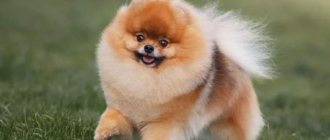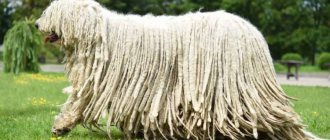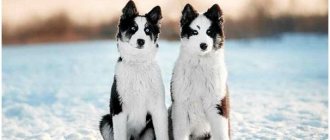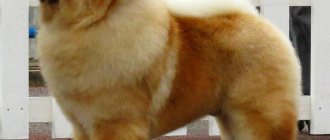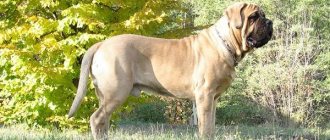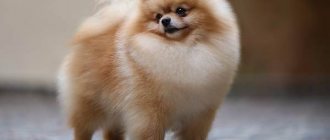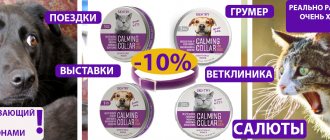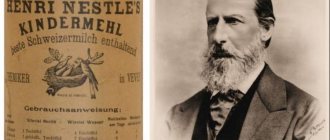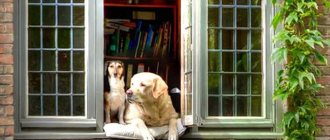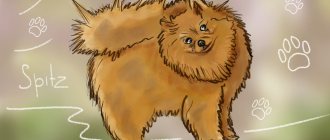Home » Dog Breeds
Did you know that dogs may have been first domesticated in Africa? Many scientists support this version. As a result of many years of isolation, many original and distinctive breeds appeared in Africa. However, before purchasing such a puppy, it is necessary to take into account some nuances related to the nature of the pets.
- 2 Rhodesian Ridgeback
- 3 South African Boerboel
- 4 Azawakh
- 5 Africanis
- 6 Arabian Greyhound
Basenji
- Height: from 38 to 43 cm
- Weight: from 9 to 12 kg
- Life expectancy: 12 to 16 years
- Average cost: from 1500 to 2000 dollars
Agile and feisty, the Basenji is often called the African non-barking dog . However, don’t be fooled, instead of the typical barking of their fellow Basenjis, they yodel, somewhat reminiscent of an air raid siren!
While there are many qualities that make the Basenji so special, the fact that they are considered the oldest African dog breed is perhaps the most impressive.
These relatively small dogs are famous for their unusually curled tails, high intelligence and independent temperament. Basenjis love their owners, especially those who provide them with exercise and activities to keep their minds sharp. If these Central African hunting dogs are left alone for long periods of time, they will become bored and begin to behave destructively.
How to choose a puppy
It should be remembered that you should not take animals from your hands or at the market: in this case, there is a high chance of buying a sick puppy. You need to contact only trusted breeders who have all the necessary certificates and licenses. The puppy must be chosen personally; it is optimal to introduce the dog at the age of 8 weeks, after quarantine and vaccination.
- You need to request a medical card from the breeder, which contains information about the health of the parents and puppies.
- A healthy dog should be active, playful, and not too skinny.
- The eyes and ears should be clean and the coat should be smooth and shiny.
- Before buying a dog, you should evaluate your own strengths and familiarize yourself with the requirements for keeping the animal - this is the only way to achieve comfort for the pet.
The dog is not suitable for people who prefer a passive lifestyle, as well as for people with an unrestrained and harsh character.
5 / 5 ( 1 voice )
Boerboel
- Height: from 59 to 70 cm
- Weight: from 55 to 79 kg
- Life expectancy: 10 to 12 years
- Average cost: from 2000 to 4000 dollars
The Boerboel is a massive South African dog, also known as the South African Mastiff or African Lion Dog. These agile and brave 70-pound gentle giants are still a relatively rare breed of dog .
The origin of the Boerboel is still a mystery. It is believed to be part mastiff (imported by the Dutch) and part native African dog.
With good socialization and training, Boerboels make incredibly loyal family guard dogs (they usually love children). The only condition is that there is enough space to play, so this may not be the best choice for a pet for living in a city apartment.
Distinctive features
These dogs have all the external qualities of mastiffs: a large and strong body of an elongated format, a large head with a strong jaw and a wide muzzle, wrinkles on the face, pronounced outlined muscles. The animal is large, males can reach 70 cm , and females 65 , weight sometimes reaches 70-90 kg . The gender type is clearly expressed, girls are smaller and more harmonious than males.
- The head is medium-sized, short, wide and deep, flat between the ears. Stop is expressed. The cheekbones are large and sinewy. The furrow between the eyes is visible.
- The muzzle is longer than the head, wide and square, slightly tapering towards the nose. The bridge of the nose is straight. The jaw is strong with a full set of teeth. bite (the upper teeth overlap the lower teeth). Lips are soft and dense. The upper one overlaps the lower one (thin, not jagged), but does not reach the edge of the jaw.
- The nose is large with open nostrils, black.
- The eyes are round, set straight, wide and deep. Covered with black eyelids. The color of the iris is brown (dark).
- The ears are semi-erect, set high and wide. The shape resembles a "V". When active, they rise.
- The body is long, rectangular, well built, strong. The back is wide, straight, muscular. The loin is convex. The chest is well descended. The neck is short with a convex scruff.
- The tail is set high, carried above the loin, thick and strong. It is customary to dock at 2/3.
- The limbs are muscular, straight and parallel. The paws stand straight, large, gathered into a ball. The movements are confident, powerful, with a good rear push.
- The coat is short, hard, smooth and dense.
- The skin fits tightly, and thin folds form on the muzzle.
- Color: shades of brown, red, brindle.
Rhodesian Ridgeback
- Height: from 61 to 69 cm
- Weight: from 29 to 41 kg
- Life expectancy: 10 to 12 years
- Average cost: from 1000 to 1800 dollars
Experienced dog owners who want a loyal and affectionate hunting and running companion will love the Rhodesian Ridgeback. Strong and playful, this dog was originally bred to hunt large game in Africa (including lions), which is why it was formerly called the African Lion Hound .
They are considered intelligent and fairly obedient companions, but it is important to socialize and train them as early as possible as Rhodesian Ridgebacks are renowned for their willfulness and stubbornness. Ideal for outdoor activities, the Rhodesian Ridgeback makes an ideal partner for joggers or hikers.
Saluki
- Height: from 58 to 71 cm
- Weight: from 18 to 27 kg
- Life expectancy: 12 to 14 years
- Average cost: from 1700 to 2700 dollars
Slender, elegant and fast, Salukis are happy to race long distances, so make sure your enclosure is securely closed. About 65 km/h is their average speed! Beneath the flowing locks is a strong and resilient dog, ideal for active families living in warm climates.
Did you know that the beauty of the Saluki has been admired for thousands of years? It was once the favorite dog of Egyptian and Middle Eastern royalty.
It is very important to exercise this breed daily, as well as offer it plenty of mental stimulation - otherwise destructive behavior will be inevitable. That being said, Salukis do best with consistent training with positive reinforcement.
Reviews
Maria, Rostov-on-Don: “These dogs are excellent companions for both adults and children. Basenjis are playful, intelligent, active and at the same time so affectionate - just seeing them nearby makes you smile.”
Sergey, Volgograd: “The silent Basenji breed has a picky character. Their small size makes them easy to keep even in an apartment. Basenjis require constant training and movement.”
Anna, Voronezh: “Good, cheerful and active dogs. Very independent and smart. A huge plus is their cleanliness and ability to get along with the child. The only disadvantage I know of the Basenji breed so far is disobedience.”
Pharaoh Hound
- Height: from 53 to 63 cm
- Weight: from 18 to 27 kg
- Life expectancy: 11 to 14 years
- Average cost: from 1800 to 2500 dollars
Another Egyptian breed noted in ancient manuscripts is the aptly named Pharaoh Hound. Noble, intelligent and endlessly playful, they are also skilled hunting dogs. On the other hand, they can make affectionate and energetic pets who love spending time with their people.
Fun fact: When a Pharaoh Hound is happy, it "smiles" by showing its teeth, happily wagging its tail, and moving its entire body. These expressive dogs can also blush just like us: when Pharaoh Hounds are excited, their noses and ears turn pink.
One of the oldest breeds of domestic dogs, this dog is quite rare and unusual, although it can sometimes be found in coursing or agility competitions. Eager to please their human parents, Pharaoh Hounds are highly trainable and excel at positive reinforcement training.
Diseases and health problems
African Terriers are generally healthy, but like all breeds, they are susceptible to certain health conditions. Not all Basenjis may have one or another condition, but it is important to be aware of them.
Fanconi syndrome is a kidney disease that affects the normal processing of sugars and proteins. In this case, the protein necessary for survival is washed away.
Signs of the disease include:
- Excessive thirst;
- Frequent urination;
- Increased glucose levels in urine.
Usually diagnosed in dogs between 4 and 7 years of age. Fanconi syndrome used to be considered fatal, but a new way to combat this disease has increased the duration. Treatment is not necessarily expensive, but it is time-consuming. The breeder should show you which dogs in the pedigree have had offspring with Fanconi syndrome and which have not.
Immunoproliferative systemic bowel disease, commonly called malabsorption, is similar to irritable bowel disease in humans. These dogs seem to have a constant allergic reaction to food. They have chronic loose stools and problems with weight gain. Treatment includes minimizing stress, frequent dietary changes, and reducing the histamine response with medications.
Pyruvate kinase deficiency (hemolytic anemia). This is a genetic condition where there are two defective genes for the production of pyruvate kinase, an enzyme needed to maintain healthy red blood cells. Animals with this disease usually do not live to see their second birthday.
Hypothyroidism is caused by a deficiency of thyroid hormone and can lead to infertility, obesity, mental dullness and lack of energy. The dog's fur may become rough and brittle and begin to fall out, and the skin may become rough and dark. The disease can be managed very well by taking daily thyroid hormone replacement pills. The medicine must be taken throughout the dog's life.
Residual pupillary membrane is strands of tissue in the eye, remnants of the fetal membrane that nourished the lenses of the eyes before birth. They usually disappear by the time the puppy is 4 to 5 weeks old, but sometimes they persist. The filaments may extend across the iris, from the iris to the lens, or from the cornea to the iris, and are sometimes found in the anterior chamber of the eye. For many dogs, this defect does not cause any problems and usually disappears by 8 weeks. If the threads do not dissolve, they can cause cataracts or corneal opacity. Eye drops prescribed by your veterinarian may help.
Coloboma is a common name to describe a gap or hole in the structure of the eye. The rupture can occur anywhere in the eye, usually at the bottom. It is likely that the disease is hereditary. The effects of the condition can be mild or severe depending on the size and location of the hole. Affected puppies must be neutered to prevent them from passing on the condition.
Progressive retinal atrophy is a series of eye diseases that involves the gradual deterioration of the retina. At the beginning of the disease, pets have difficulty seeing at dusk. As the disease progresses, they also lose daytime vision. Many dogs adapt very well to limited or complete loss of vision as long as their environment remains the same.
Hip dysplasia – this disease is inherited. The femoral head does not fit well to the joint. Animals may experience pain or limp on one or both legs, but you may not notice any signs of discomfort. As your dog ages, arthritis can develop. If suspected, an x-ray examination is necessary. Dogs with dysplasia should not be bred.
Coton de Tulear
- Height: from 22 to 30 cm
- Weight: from 3.5 to 6 kg
- Life expectancy: 14 to 16 years
- Average cost: from 600 to 2100 dollars
Madagascar is not just an exclusive resort for various species of lemurs, it is also home to the pampered Coton de Tulear. Although the Coton de Tulear looks a bit like a Maltese, this tiny breed is beautiful and unique in its own way. Named after their place of origin (Tulear, Madagascar), these dogs are renowned for their fluffy, cotton-like fur that is low-shedding and (mostly!) hypoallergenic.
Friendly, playful and easy to care for, these dogs are ideal for families with children. And with a long life expectancy (up to 16 years!), you'll have many years to spend together.
Key points in training
Training Bulls is a responsible business. These dogs are prone to dominance over humans, so from the first days the owner must show his superiority and leadership in the family. The pet must clearly understand that it is impossible to manipulate, understand the basic rules of behavior: you cannot bite household members, pull the leash, beg, eat from the table or from your hands, pick up garbage from the floor and ground.
Training begins at 4-5 months. Then the animal is taught basic commands. You can give your pet to a kennel club for fostering. There, experts will advise a specific direction of training.
The use of cruel methods is prohibited. You cannot beat a dog or mock it.
Reprimand, a stern look, or a shout will do. In extreme cases, when the pet becomes uncontrollable, it is advised to press it to the ground and hold it until it comes to its senses.
Read about how to properly train a dog in the article: “Training a puppy: effective methods from dog handlers, learning commands at home.”
Aidi
- Height: from 52 to 62 cm
- Weight: about 25 kg
- Life expectancy: 11 to 12 years
- Average cost: from 450 to 1100 dollars
Another rare breed, especially in Russia, the Aidi is a superb African Shepherd dog originally from the Atlas Mountains. From time immemorial they protected livestock throughout Algeria, Morocco and Tunisia. Possessing thick fur that protects them from ferocious predators, Aidi take their work seriously and are not afraid of difficulties.
IMPORTANT! Known to be territorial, these dogs definitely need early and extensive socialization and training - otherwise their wild instincts can take over.
Breeding
The pregnancy of an African husky female lasts 56-73 days - in terms of timing, everything is individual and does not depend on external signs. You need to feed your Basenji dog high-quality and high-calorie food in order to provide vitamins and nutrients to future offspring. The birth must be attended by a veterinarian, so you should agree with him in advance. After the birth of Basenji puppies, they and their mother need to continue to receive enhanced healthy nutrition.
After the puppies are 21 days old, they need to be dewormed (or “wormed”). An adult dog undergoes this procedure even before pregnancy.
From the age of two months, Basenji puppies must be vaccinated in accordance with their personal vaccination schedule. This is best done with imported medicines.
It is also necessary to carry out certification of Basenji puppies - this is an examination to control the breeding of animals. The head of the breed visits the owner’s home or kennel, assesses the well-being of the mother dog and examines her offspring. Next, a general card is created for all Basenji puppies and an individual card for each of them, which describes their appearance, the condition of the coat, teeth and bite of the animals. They also pay special attention to the living conditions and breeding conditions of dogs.
Slugi
- Height: from 61 to 72 cm
- Weight: from 18 to 28 kg
- Life expectancy: 12 to 16 years
- Average cost: about $1,200
Although the breed's origins are a bit murky, few dogs know the North African deserts better than the ancient Slugs. This graceful dog with fast legs is designed for running . Slugs are excellent hunters of gazelles, wild pigs and foxes, so it is not surprising that their nickname is “Arabian hound”.
These pets are likely to be reserved with strangers, but very attentive to their people. Slugs require daily exercise from their owners, although they are also happy to laze around at home for some time.
Description
The key feature of the species of such dogs is their emergence and development without human selection intervention. The description of the breed gives a clear idea of the appearance of the Basenji even to those who have never encountered these pets.
Thanks to living in natural conditions, the dog has developed muscles and good coordination. The Basenji's coat is short, thick and shiny. These animals are excellent hunters with excellent senses, so it is vital for them to exercise a lot in order to be healthy dogs.
Expert opinion
Anna Abramenko
An avid dog lover. Experience in veterinary medicine since 2009.
Ask a Question
One of the most striking features of the Basenji breed is that the dogs cannot bark at all. At the same time, the animal’s vocal cords are normally developed and function correctly - they can howl, purr, purr, and emit something similar to laughter.
Azawakh
- Height: from 60 to 74 cm
- Weight: from 15 to 25 kg
- Life expectancy: 10 to 12 years
- Average cost: from 2000 to 2500 dollars
Native to the West African countries of Burkina Faso, Mali and Niger, the Azawakh only arrived in Europe in the 1970s . These dogs were highly valued by nomads and were treated like family members. The Azawakhs took their job of protecting settlements and hunting game (such as gazelles and wild boars) very seriously.
Although the breed may look like a greyhound, it actually has much longer legs and is slightly slimmer (if that's even possible!). The good-natured and gentle Azawakh needs daily positive mental and physical stimulation. This breed responds best to reward-based training.
List of suitable nicknames
For representatives of such an ancient and unusual Basenji breed, you need to carefully select a nickname - simple, but at the same time not banal. Long names are difficult for dogs to hear and react poorly to them. Below are lists in alphabetical order of the most popular nicknames for both genders.
For Basenji males you can choose the following original and beautiful nicknames:
- Akella;
- Anubis;
- Antey;
- Jack;
- Varangian;
- Viking;
- Veles;
- Hector;
- Hero;
- Dobby;
- Jackson;
- Elisha;
- Jean;
- Zeus;
- Zorro;
- Icarus;
- Indigo;
- Ethan;
- Cake;
- Kent;
- Larry;
- Life;
- Martin;
- Nick;
- Orpheus;
- Pirate;
- Prince;
- Ray;
- Ricky;
- Scythian;
- Volume;
- Tim;
- Uranus;
- Hulk;
- Hugo;
- Chester;
- Sherlock;
- Shepard;
- Eddie;
- Ernie;
- Yucca;
- Cabin boy;
- Jason;
- Yard.
For bitches of this breed, there is also a wide choice of options for what to call her in an unusual and sonorous way:
- Aurora;
- Agatha;
- Akira;
- Bagheera;
- Bonnie;
- Vesta;
- Vicki;
- Wendy;
- Hera;
- Grace;
- Dana;
- Daisy;
- Eve;
- Elana;
- Christmas tree;
- Jasmine;
- Zara;
- Xena;
- Irma;
- Ida;
- Kira;
- Kelly;
- Lana;
- Laura;
- Martha;
- Mila;
- Mary;
- Carry;
- Nutti;
- Audrey;
- Omega;
- Pandora;
- Puma;
- Rona;
- Rachel;
- Sally;
- Sparta;
- Tilde;
- Tory;
- Ulma;
- Phoebe;
- Frida;
- Hannah;
- Hayley;
- Cherry;
- Amber;
- Emmy;
- Yula;
- Yanni.
Africanis
- Height: from 50 to 62 cm
- Weight: about 35 kg
- Life expectancy: 9 to 12 years
- Average cost: about $650
The nickname "African Dog" best describes this nomadic classic herding breed, as Africanis are the true embodiment of the indigenous dogs of the dark continent south of the equator. With a strong protective instinct (thanks to centuries of experience protecting human settlements and livestock), this breed makes family loyalty a priority.
Did you know that this is one of the few dog breeds in the world that developed and is still developing without human intervention.
These friendly and highly athletic dogs are naturally people-oriented and enjoy spending time with them, such as hiking, running, and agility training.
Greyhound
- Height: from 68 to 76 cm
- Weight: from 26 to 40 kg
- Life expectancy: 10 to 14 years
- Average cost: from 1500 to 2500 dollars
This classic greyhound has Egyptian and Greek roots. The graceful greyhound is a favorite of kings and presidents. These hunting dogs enjoy long walks and chasing squirrels, which often attract their attention in parks. While humans have a visual range of about 180 degrees, greyhounds boast a 270-degree visual range . While walking, their wide-set eyes are always looking out for potential prey; even at a distance of 800 meters, a keen-eyed greyhound will notice a lurking animal!
Fun fact: The greyhound is the only dog mentioned in the English version of the King James Version of the Bible (Proverbs 30:29-31).
Greyhounds are often called "cat dogs" due to their regal, proud demeanor. On the other hand, these greyhounds have a gentle and kind disposition, are easy to train and, of course, are looking for a reliable running partner.
Abyssinian sand terrier
- Height: from 39 to 52 cm
- Weight: from 9.5 to 17.7 kg
- Life expectancy: 12 to 15 years
- Average cost: unknown
One of the most unique African dog breeds is the Abyssinian Sand Terrier. Also known as the African Hairless Dog, this motley dog is native to Abyssinia, now present-day Ethiopia. Few facts have been collected about the origin of the Abyssinian sand terrier. One of the first specimens brought to Europe is on display in the dog gallery of the British Museum of Natural History in Tring.
Fun fact: People used to believe that the Abyssinian Sand Terrier had magical healing powers , so its warm body was used to warm the bed in winter and heal pain or aching joints.
Representatives of this breed have virtually no hair on their body, with the exception of a few tufts on the head and tail, and some individuals are completely hairless. Interestingly, this very rare breed of African dog is considered the progenitor of some modern hairless dog breeds, including the Chinese Crested Dog.
Video
* We invite you to watch a video about the Basenji . In fact, in front of you is a playlist in which you can select and watch any of 20 videos about a given dog breed by simply clicking on the button in the upper right corner of the window. In addition, the material contains quite a lot of photos. By looking at them you can find out what a Basenji looks like.
In this article:
|
African wild dog
- Height: from 60 to 75 cm
- Weight: from 18 to 36 kg
- Life expectancy: about 10 years
- Average cost: unknown
This is the only African dog we won't see at the dog park! It is sometimes also called the African Wolfdog. Outwardly, it vaguely resembles a spotted hyena. This is one of the fastest dying mammals. African wild dogs used to live in 39 countries, with populations numbering in the hundreds of thousands. There are currently only 1,500 individuals . These ancient predators live primarily in the grasslands, forests and deserts of Mozambique and Tanzania.
Did you know that the African wild dog can reach speeds of up to 72.4 km/h!
Based on materials from: www.dailypaws.com
